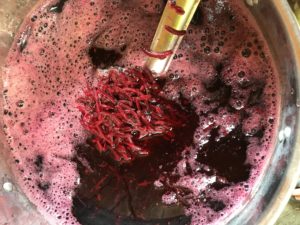Beet root is an unconventional and some would say risky source of natural dye. After a few trials over the past two years, I stumbled on a method that yielded saturated color, and I’m sharing my notes in the hopes that others will give it a try.
Step 1: Prepare the yarn.
Mordant the wool with alum. I use a 10% by weight-of-goods proportion of alum to wool. Botanical Colors has a great tutorial on mordanting with alum.
Step 2: Prepare the beets.
I used beets that were too fibrous to eat. For one pound of yarn, I used 20 pounds of freshly harvested beets. To extract the most color, I used the grater attachment on a food processor to shred the material into small pieces. Then place the beet pulp (juice and all) into your dye kettle.
Step 3: Extract the dye and wet the yarn.
Place the pot on your heat source and top up with warm water, then add heat and bring to a gentle simmer (180 – 190 F). Stir occasionally and cook for at least an hour.
While the color is extracting, wet your yarn out in hot water in a covered container (like a bucket or extra pot with a lid) to retain the heat.
When the color of the dye is looking saturated, strain off the liquid into another pot or bucket. I use a mesh paint strainer for this purpose to catch all the fine plant material, and wear heat-proof gloves so I can squeeze the bag and get all the dye out.
Step 4: Dye the fiber.
Pour the dye liquid into your dye kettle and place back on the heat source.
Gently lift your yarn or fiber out of the soaking container and place into the dye kettle. Give it a gentle stir and poke to submerge.
Simmer the yarn in the dye bath for at least two hours, giving it a gentle swish every once in a while (too much agitation can felt the yarn so stirring should be infrequent).
Towards the end of the cooking process, add a food-safe acid to lower the pH to 3.5. I used citric acid which I buy in crystal form from a natural dye supplier.
Keep cooking the yarn a bit longer after adding the acid, about 20-30 minutes. Then, turn off the heat and cover the pot, and allow the yarn to rest and cool in the dye bath overnight.
Step 5: Rinse and dry.
Gently lift the fiber out of the dye kettle and allow the excess dye liquor to drain back into the pot. Hopefully, the color has affixed to the yarn to produce a saturated tone.
Then transfer the yarn to a bucket of clean water and let soak for a couple of minutes. If necessary, lift the fiber out of the rinse bucket and place into a third bucket or pot of clean water, to rinse a second time.
In a shady spot, hang or drape the wet yarn to dry. You might want to bring the yarn inside after it stops dripping, as humidity in the air can keep it from drying completely outside.
Have you tried dying with beetroot or other kitchen scraps? We’d love to know. Leave a comment here or on the accompanying video and let us know how it turned out.




Dye wool with tansy | Vermont Craft Tours
March 4, 2018 at 5:47 pm[…] a quick note before the recipe for Tansy: In the video I noted that my beet dye wasn’t very color-fast when exposed to light over a week. Live and […]